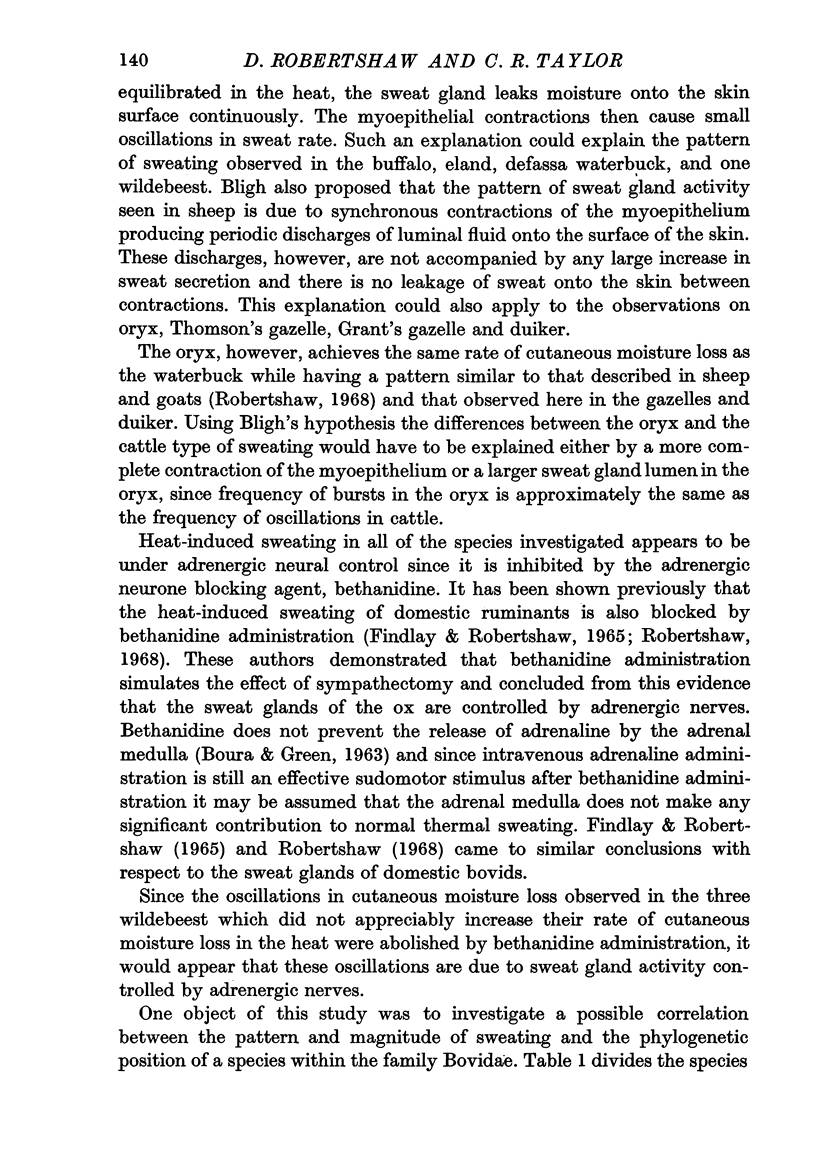Abstract
1. The pattern and control of the sweat glands of eight species of wild bovids has been studied.
2. Heat exposure resulted in changes in cutaneous moisture loss which showed considerable species variation. Duiker, Grant's gazelle, Thomson's gazelle and oryx all demonstrated periodic discharges of moisture on to the surface of the skin. Defassa waterbuck and eland exhibited discharges which were accompanied by a gradual rise in basal level. Buffalo showed an immediate large increase which was sustained during the period of heat exposure. Three wildebeest displayed small fluctuations whilst a fourth animal showed a step-wise increment in cutaneous moisture loss.
3. The intravenous infusion of adrenaline into the buffalo and one wildebeest caused an increase in cutaneous moisture loss, the magnitude of which was directly related to the size of the dose administered. In three other wildebeest, and all other animals tested, a single injection of adrenaline was necessary to cause a discharge of moisture on to the surface of the skin. Noradrenaline was without effect.
4. Heat-induced but not adrenaline-induced sweating was inhibited by the intravenous administration of an adrenergic neurone blocking agent, bethanidine.
5. It is concluded that the sweat glands of the wild bovids studied are under adrenergic neurone control, in common with the domestic bovids previously studied, and that there is no correlation between the pattern of sweating and the phylogenetic position of the species.
Full text
PDF








Selected References
These references are in PubMed. This may not be the complete list of references from this article.
- BOURA A. L., GREEN A. F. Adrenergic neurone blockade and other acute effects caused by N-benzyl-N'N"-dimethylguanidine and its ortho-chloro derivative. Br J Pharmacol Chemother. 1963 Feb;20:36–55. doi: 10.1111/j.1476-5381.1963.tb01295.x. [DOI] [PMC free article] [PubMed] [Google Scholar]
- Bligh J. A thesis concerning the processes of secretion and discharge of sweat. Environ Res. 1967 Jun;1(1):28–45. doi: 10.1016/0013-9351(67)90004-7. [DOI] [PubMed] [Google Scholar]
- CRAWFORD E. C., Jr Mechanical aspects of panting in dogs. J Appl Physiol. 1962 Mar;17:249–251. doi: 10.1152/jappl.1962.17.2.249. [DOI] [PubMed] [Google Scholar]
- Findlay J. D., Robertshaw D. The role of the sympatho-adrenal system in the control of sweating in the ox (Bos taurus). J Physiol. 1965 Jul;179(2):285–297. doi: 10.1113/jphysiol.1965.sp007663. [DOI] [PMC free article] [PubMed] [Google Scholar]
- Hales J. R., Findlay J. D. The oxygen cost of thermally-induced and CO2-induced hyperventilation in the ox. Respir Physiol. 1968 May;4(3):353–362. doi: 10.1016/0034-5687(68)90040-6. [DOI] [PubMed] [Google Scholar]
- MCLEAN J. A. Measurement of cutaneous moisture vaporization from cattle by ventilated capsules. J Physiol. 1963 Jul;167:417–426. doi: 10.1113/jphysiol.1963.sp007159. [DOI] [PMC free article] [PubMed] [Google Scholar]
- MCLEAN J. A. The partition of insensible losses of body weight and heat from cattle under various climatic conditions. J Physiol. 1963 Jul;167:427–447. doi: 10.1113/jphysiol.1963.sp007160. [DOI] [PMC free article] [PubMed] [Google Scholar]
- Robertshaw D. The pattern and control of sweating in the sheep and the goat. J Physiol. 1968 Oct;198(3):531–539. doi: 10.1113/jphysiol.1968.sp008623. [DOI] [PMC free article] [PubMed] [Google Scholar]
- Whittow G. C., Findlay J. D. Oxygen cost of thermal panting. Am J Physiol. 1968 Jan;214(1):94–99. doi: 10.1152/ajplegacy.1968.214.1.94. [DOI] [PubMed] [Google Scholar]


